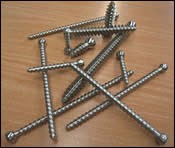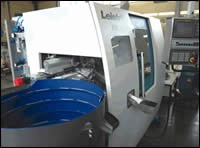Whirling As A Separate Operation
For those looking for a faster, more economical method of producing bone screws, whirling as a separate operation may be an option.
For those looking for a faster, more economical method of producing bone screws, whirling as a separate operation may be an option. The whirling process has made great strides throughout the last several years, and this efficient and fast method of producing threads has recently been integrated into Swiss-type screw machines. However, according to Ralph Wehmann, national sales manager for Leistritz Corporation (Allendale, New Jersey), the combination of these operations does not contribute to the “lean” goal of high productivity—performing as many operations as possible in a single machine. “It is the philosophy of Leistritz that separating operations is more productive,” Mr. Wehmann says. “The very features that make Swiss-type turning centers a great choice for turning small-diameter long shafts, screws and spindles are exactly what make them less-efficient whirling machines.”
Feeding the bar material through a guide collet has the disadvantage of not permitting continuous rough and finish turning over a long length. Therefore, whirling a long screw requires either incremental turning and whirling steps across the entire screw length or whirling the screw without turning the blank to the thread major diameter first. Both of these alternatives are time-consuming and can introduce unnecessary inaccuracies.
The Leistritz concept is to turn bone screw blanks in existing Swiss-type turning centers without the thread. This process allows an even shorter cycle time and greater throughput per machine. Then, a machine designed specifically for whirling produces the thread. Leistritz whirling machines are designed to have the necessary following supports to permit whirling of screws of any profile or length, and most bone screws, even in their longest designs and in either 316L stainless steel or Titanium, can be whirled in less than 60 seconds.
Leistritz has developed a line of multi-axis CNC machines designed specifically for whirling, with an inherent rigidity for cutting deep, wide profiles in tough materials and accuracy for cutting precision, close-tolerance screws. Workpiece capacities for the machines range from 0.2 inch to 0.6 inch for the PW 65 machine to 0.5 inch to 4.0 inches for the PW 160. Lengths are from 8.5 inches to 19.7 inches. The machines provide between 2.5 hp and 10 hp, and whirling speeds are from 2,280 rpm to 12,000 rpm. Siemens, Fanuc or Allen Bradley controls are available for each machine.
The PW-65MED machine features an automatic parts loader and hopper system. The pre-turned blanks, with either finished or unfinished heads, are dumped into the vibratory hopper, which aligns the screw blanks to be oriented tip-first and funneled to the staging area. Once “on deck” for the loading process, each screw is measured for length with a light beam, and the proper CNC program is selected to run for the appropriate screw length. This is an effective tool because almost all bone screws are produced in families of the same diameter. Typical bone screws of the same family vary only in length from 10 mm to a maximum of 100 mm, in 5-mm increments. With this whirling machine, all screws within the same family can be produced simultaneously without any setup.
This processing also allows cell integration of a number of turning centers to each whirling machine. Typically four or possibly five turning centers produce the blanks (of various lengths) for a single PW-65MED whirling machine.
Leistritz whirling machines can now be equipped with remote diagnostic software. This option provides customers with online problem-solving analysis of their machines by the company’s technical support personnel. Machine problems such as programming difficulties, electronic issues and mechanical error messages can be diagnosed and, in most cases, solved remotely. Customers also benefit from the added advantage of working with application engineers who can help with application difficulties.
Remote diagnostic functions include simple soft-key operation to set the machine control into remote diagnostic mode. Once the machine is in diagnostic mode, Leistritz personnel have the same functionality and screen data as the machine operator, allowing them to quickly analyze the machine operations and error message. Data transfer of CNC programs, machine parameters and PLC software is also possible to allow review and troubleshooting of all aspects of the operation. Message transmissions can be exchanged between the machine operator and technical support personnel in either direction through the CNC control.
According to Mr. Wehmann, “Medical screw manufacturers throughout the country and in Europe are fast discovering this alternative method of production. When production volumes increase to the point where more than one turning center is required, this separation of operations can save even more, maximizing the use of all machines in a cell.” The low tooling costs combined with short cycle times and minimal setup time required with this process can provide surprising benefits to a company’s bottom line.
Read Next
Putting More Teeth In Thread Whirling
When it comes to producing OD threads in difficult-to-machine metals, few processes are as fast or as efficient as the thread whirling process. Although the process is not new, its popularity is increasing because of the growing availability of thread whirling tooling for single-spindle Swiss screw machines that provides a relatively inexpensive alternative to investing in dedicated thread whirling machines.
Read MoreBoning Up On Thread Whirling's Advantages
Thread whirling attachments installed on this bone screw maker's Swiss screw machines prove to be just the right prescription for the company's mix of screw sizes and run quantities.
Read MoreHow To (Better) Make a Micrometer
How does an inspection equipment manufacturer organize its factory floor? Join us as we explore the continuous improvement strategies and culture shifts The L.S. Starrett Co. is implementing across the over 500,000 square feet of its Athol, Massachusetts, headquarters.
Read More





















